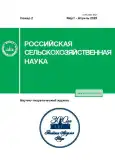Resistance of rice Oryza sativa L.. doubled haploids to lodging for the far eastern breeding
- Авторлар: Ilyushko M.V1, Romashova M.V1, Guchenko S.S1
-
Мекемелер:
- Chaika Federal Scientific Center for Agrobiotechnology of the Far East
- Шығарылым: № 2 (2023)
- Беттер: 30-34
- Бөлім: Articles
- URL: https://journals.rcsi.science/2500-2627/article/view/144601
- DOI: https://doi.org/10.31857/S2500262723020072
- EDN: https://elibrary.ru/AOYHGU
- ID: 144601
Дәйексөз келтіру
Толық мәтін
Аннотация
Негізгі сөздер
Авторлар туралы
M. Ilyushko
Chaika Federal Scientific Center for Agrobiotechnology of the Far East
Email: ilyushkoiris@mail.ru
692539, Primorskii krai, Ussuriisk, pos. Timiryazevskii, ul. Volozhenina, 30
M. Romashova
Chaika Federal Scientific Center for Agrobiotechnology of the Far East692539, Primorskii krai, Ussuriisk, pos. Timiryazevskii, ul. Volozhenina, 30
S. Guchenko
Chaika Federal Scientific Center for Agrobiotechnology of the Far East692539, Primorskii krai, Ussuriisk, pos. Timiryazevskii, ul. Volozhenina, 30
Әдебиет тізімі
- Genealogy of the "green revolution" gene in rice / H. Nagano, K. Onishi, M. Ogasawara, et al. // Genes. Genet. Syst. 2005. Vol. 80. P. 351-356. doi: 10.1266/ ggs.80.351.
- QTL-seq-based genetic analysis identifies a major genomic region governing dwarfness in rice (Oryza sativa L.) / G. Kadambari, L. R. Vemireddy, A. Srividhya, et al. // Plant. Cell. Reports. 2018. Vol. 37. P. 677-687. doi: 10.1007/s00299-018-2260-2.
- Three genetic systems controlling growth, development and productivity of rice (Oryza sativa L.): a reevaluation of the "green revolution" / F. Zhang, Y.-Z. Jiang, S.-B. Yu., et al. // Theor. Appl. Genet. 2013. Vol. 126. P. 1011- 1024. doi: 10.1007/s00122-012-2033-1.
- Deep rooting conferred by DEEPER ROOTING1 enhances rice yield in paddy fields / Y. Arai-Sanoh,T. Takai, S. Yashinaga, et al. // Sci. Rep. 2014. Vol.4. Article 5563. URL: https://www.nature.com/articles/srep05563 (дата обращения: 21.05.2022). doi: 10.1038/srep05563.
- Valluru R., Reynolds M. P., Salse J. Genetic and molecular bases of yield-associated traits: a translational biology approach between rice and wheat // Theor. Appl. Genet. 2014. Vol. 127. P. 1463-1489. doi: 10.1007/ s00122-014-2332-9.
- Гончарова Ю. К., Гончаров С. В., Чичарова Е. Е. Локализация хромосомных регионов, определяющих эффективность фотосинтеза у российских сортов риса // Генетика. 2018. T. 54. № 7. С. 785-794. doi: 10.1134/S0016675818070032.
- Development and validation of allele-specific SNP/ indel markers for eight yield-enhancing genes using whole-genome sequencing strategy to increase yield potential of rice Oryza sativa L. / S. Kim, J. Ramos, M. Ashikari, et al. // Rice. 2016. Vol. 9. Article12. URL: https://thericejournal.springeropen.com/articles/10.1186/s12284-016-0084-7 (дата обращения: 26.05.2022). doi: 10.1186/s12284-016-0084-7.
- Rational desigh of high-yield and superior-quality rice / D. Zeng, Z. Tian, Y. Rao, et al. // Nature Plants. 2017. Vol. 3. Article 17031. URL: https://www.nature.com/articles/nplants201731 (дата обращения: 18.12.2021). doi: 10.1038/nplants.2017.31.
- Effect of rice breeding process on improvement of yield and quality in China / F. Cheng, X. Quan, X. Znengjin, et al. // Rice Sci. 2020. Vol. 27. No. 5. P. 363-367. doi: 10.1016/j.rsci.2019.12.009.
- Isolation of a novel lodging resistance QTL gene involved in strigolactone signaling and its pyramiding with aQTL gene involved in another mechanism / K. Yano, T. Ookawa, K. Aya, et al. // Molecular Plant. 2015. Vol.8. P. 303-314. doi: 10.1016/j.molp.2014.10.009.
- Genome-wide binding analysis of the transcription activator IDEAL PLANT ARCHITECTURE1 reveals a complex network regulating rice plant architecture / Z. Lu, H. Yu, G. Xiong, et al. // Plant Cell. 2013. Vol. 25. P. 3743-3759. doi: 10.1105/tpc.113.113639.
- Regulation of OsSPL14 by OsmiR156 defines ideal plant architecture in rice / Y. Jiao, Y. Wang, D. Xue, et al. // Neture Genetics. 2010. Vol. 42. No. 6. P. 541-545. doi: 10.1038/ng.591.
- Molecular breeding of "Swarna", a mega rice variety for lodging resistance / G. R. Merugumala, P. V. Satyanarayana, N. Chamundeswari, et al. // Mol. Breeding. 2019. Vol. 39. Article 55. URL: https://link.springer.com/article/10.1007/s11032-019-0961-z (дата обращения: 11.11.2021). doi: 10.1007/s11032-019-0961-z.
- Morphological and molecular characterization of new plant type core set for yield and culm strength traits in rice (Oryza sativa L.) / R. Bagudam, K. B. Eswari, J. Badri, et al. //j. Plant Biochem. Biotechnol. 2021. Vol. 30. P. 233-242. doi: 10.1007/s13562-020-00581-w.
- Sarao N. K., Gosal S. S. In vitro androgenesis for accelerated breeding in rice // Biotechnologies of crop improvement. Springer, Cham. Springer International Publishing AG, Switzerland, 2018. Vol. 1. P. 407-435. doi: 10.1007/978-3-319-78283-6.
- Илюшко М. В., Гученко С. С., Ромашова М. В. Внутрикаллусная и межкаллусная морфологическая изменчивость удвоенных гаплоидов риса, полученных андрогенезе in vitro // Российская сельскохозяйственная наука, 2020. № 6. С. 11-15. doi: 10.31857/2500262720060034.
- Dependence of porosity of amorphous silicon dioxide prepared from rice straw on plant variety / L. A. Zhemnukhova, A. E. Panasenko, A. A. Artem'yanov, et al. // BioResources. 2015. Vol. 10. No. 2. P. 3713-3723. doi: 10.15376/biores.10.2.3713-3723.
- Гученко С. С., Борзаница А. А., Бельская Н. Г. Оценка селекционных образцов риса конкурсного сортоиспытания в условиях Приморского края // Дальневосточный аграрный вестник. 2021. Т. 4. № 60. С. 40-46. doi: 10.24412/1999-6837-2021-4-40-45.
- Гены сельскохозяйственных растений, модифицированные с помощью системы CRISPR/Cas / А. М. Короткова, С. В. Герасимова, В. К. Шумный и др. // Вавиловский журнал генетики и селекции. 2017. Т. 21. № 2. С. 250-258. doi: 10.18699/VJ17.244.
Қосымша файлдар









